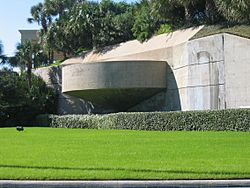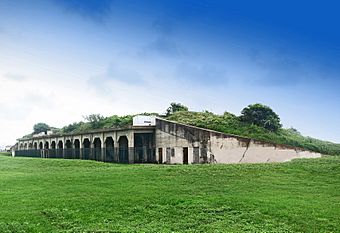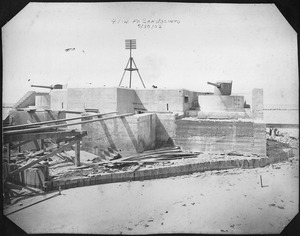Fort Crockett facts for kids
Quick facts for kids Fort Crockett |
|
|---|---|
| Galveston, Texas, United States | |

Casemate of Battery Hoskins
|
|
| Coordinates | 29°16′29″N 94°49′01″W / 29.27472°N 94.81694°W |
| Area | 40 acres (160,000 m2) |
| Site information | |
| Owner | US NOAA National Marine Fisheries Service |
| Site history | |
| Built | 1903 |
Fort Crockett is a special government area on Galveston Island in Texas. It sits right by the Gulf of Mexico. This place was first built to protect the city and harbor of Galveston. It also guarded the entrance to Galveston Bay. This helped keep the important ports of Galveston and Houston safe. It also protected the many oil refineries in the bay area.
Today, the US NOAA National Marine Fisheries Service manages Fort Crockett. It is home to a fisheries research lab. There is also the Texas Institute of Oceanography here. Some university facilities are also located on the site. You can still see several old buildings and military fortifications at Fort Crockett.
Contents
History of Fort Crockett
A military base was started on Galveston Island in the late 1890s. This was for the United States Army Coast Artillery Corps. Construction began, but it was stopped by the huge Galveston Hurricane of 1900. The United States Army Corps of Engineers spent several years rebuilding the area. They also made it bigger before soldiers could return.
In 1903, the base was named Fort Crockett. This honored Davy Crockett, a US Congressman from Tennessee. He was also a famous Texas hero from the Battle of the Alamo. After many repairs and upgrades, the US Army stationed soldiers at the fort.
During the First World War, Fort Crockett became a training center. US Army soldiers learned how to use different types of artillery here. These troops were getting ready to go to France.
In the 1920s and early 1930s, Fort Crockett housed the US Army Air Corps' 3rd Attack Group. This group focused only on attack aircraft. In 1932, Fort Crockett received eleven A-8 Shrike attack planes. These were the US military's first all-metal combat aircraft. After 1934, the 3rd Attack Group moved to Louisiana.
During the Second World War, Fort Crockett grew even more. A large new gun battery was added. The main goal was to defend against German U-boats. The fort also served as a German POW camp for prisoners of war.
After the war, Fort Crockett became an army recreation center. Soldiers could enjoy tennis and golf on the base. Galveston city was also a popular place for tourists. This made the fort a great spot for relaxation.
In the 1950s, Fort Crockett started a new role. It became a center for fisheries research. This work was for the US Fish and Wildlife Service.
In 1958, the Texas A&M Marine Lab moved into part of the old army barracks. In 1963, the biggest building at Fort Crockett was updated. It became home to the new Texas Maritime Academy of Texas A&M University. This school is now called the Texas A&M Maritime Academy.
One part of the fort, Battery Hoskins, was very strong. It had huge concrete walls to protect its guns. It was too expensive to remove. For many years, these old gun positions were a popular unofficial tourist spot. In the early 1980s, a fancy hotel called the San Luis Resort was built on and around the battery. You can still see the massive concrete gun spots from the road along Galveston Beach. One gun spot now has a swimming pool on top. The other is used as a wedding gazebo.
Galveston Bay's Defenses
|
Fort Travis
|
|

Fort Travis on Bolivar Peninsula
|
|
| Location | SH 87 at Loop 108, Port Bolivar, Texas |
|---|---|
| Area | 70 acres (28 ha) |
| Built | 1898 |
| NRHP reference No. | 05000247 |
| Significant dates | |
| Added to NRHP | March 30, 2005 |
During the Texas Revolution, Galveston harbor needed protection. A small fort was built on the northeast side of Galveston Island. This spot was near the entrance to Galveston Bay. It was first named Fort Travis. This honored William B. Travis, the commander at the Alamo.
In the late 1800s, two new forts were built to guard Galveston Bay. One was on each side of the bay's mouth. The name "Fort Travis" was given to a new fort on Point Bolivar. This is the tip of the Bolivar Peninsula. It forms the east side of the bay entrance. Another new fort was built on the northeast tip of Galveston Island. It was named Fort San Jacinto. This honored the final battle of the Texas Revolution.
By the end of the 19th century, Fort Crockett became the main base for all three forts. It was located west of Galveston city. Its powerful, long-range guns could protect the entire area. By the early 1900s, Fort Crockett had the basic equipment needed. It was ready to defend Galveston from attacks by air or sea.
Coastal Artillery at Fort Crockett
From 1924 to 1940, a special unit called Battery G, 13th Coast Artillery Regiment, looked after Fort Crockett. During early World War II, two regiments of the US Army Coast Artillery Corps were based at Fort Crockett. They operated four main artillery batteries. Each battery used a different type of artillery. These regiments included the 20th Coast Artillery, 265th Coast Artillery, and parts of the 50th Coast Artillery.
These different guns were chosen over many years. They provided both long-range and quick-fire support.
- Battery Izard had eight 12-inch mortars.
- Battery Wade Hampton had two 10-inch "disappearing" guns. These guns could hide after firing.
- Battery Laval had two 3-inch (76 mm) guns.
- Battery Hoskins had two 12-inch (305 mm) guns.
These batteries also had fire-control buildings. Radar and anti-aircraft guns were added in the 1940s.
Coastal Artillery at Fort San Jacinto
More Coast Artillery companies were stationed at Fort San Jacinto. This fort was on the northeast tip of Galveston Island. It guarded the southern part of the entrance to Galveston Bay.
- Battery Mercer had 12-inch mortars.
- Battery Heileman had two 10-inch "disappearing" guns.
- Battery Hogan had two 4.7-inch (120 mm) guns.
- Battery Croghan had two 3-inch (76 mm) guns.
- Battery #235 had 6-inch (152 mm) guns.
- Another battery had 90 mm guns.
Coastal Artillery at Fort Travis
One more company of Coast Artillery was at Fort Travis. This fort was at Bolivar Point. It guarded the northern side of the entrance to Galveston Bay.
- Battery Kimble had two 12-inch (305 mm) guns.
- Battery Davis had two 8-inch (203 mm) guns.
- Battery Ernst had two 3-inch (76 mm) guns.
These batteries also had fire-control buildings. Radar was added in the 1940s. Fort Travis also had a train track until 1942.





